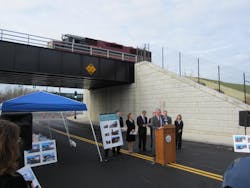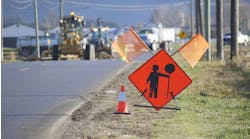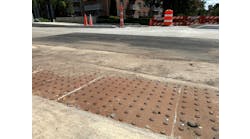On Nov. 29, 2011, the ribbon was cut on the very first project in the nation funded by a federal TIGER grant. Notably, the project finished four months ahead of schedule and paves the way for a highly anticipated commuter rail line that will link Massachusetts’ south coast to the city of Boston.
The project involved the reconstruction of three structurally deficient railway freight bridges in New Bedford, Mass., that were hindering progress in the area. A $20 million Transportation Investment Generating Economic Recovery (TIGER) grant provided the necessary funding to restore speedier freight and passenger traffic to the area, helping to drive economic development and smart growth on New Bedford’s waterfront and throughout the region.
VHB secured the TIGER grant for its client, the Massachusetts Department of Transportation (MassDOT), in a highly competitive and discretionary selection process, requiring solid evidence that transportation enhancements would bring smart growth and economic benefit to the region. This article chronicles the project’s challenges, including the grant process, an aggressive construction schedule and its ultimate success in its early completion.
Located approximately 50 miles from Boston, New Bedford is Massachusetts’ seventh largest city and struggles with a weak economy. However, the city’s commercial fishing fleet and textile and manufacturing businesses continue to flourish. The city recently added marine technology, health care, medical devices and transportation to its economic base. The completion of the TIGER-funded bridge project is helping to boost these industries and is serving as a springboard for the long-awaited Massachusetts Bay Transportation Authority’s (MBTA) South Coast Rail commuter line.
The South Coast Rail will restore commuter rail service from South Station in Boston to New Bedford and to Fall River. The project, guided by sustainable development principles and including a regional smart-growth corridor plan, supports transportation, economic, employment, affordable housing and environmental needs. Once completed, the rail line is expected to reduce fuel consumption by 292,000 gal of gas per year.
The Deane Street, Sawyer Street and Coggeshall Street rail bridges were constructed in 1907. All three were badly deteriorated, limited only to light freight loads and a maximum speed of 5 mph for safety reasons. Reconstruction of the century-old bridges would not only support future passenger rail for the region, it would immediately enhance freight operations and improve vehicle traffic beneath the bridges.
To receive adequate funding, however, MassDOT had to first apply for the TIGER grant, which was a brand new endeavor for everyone.
Stalking the prey
The TIGER application process was very competitive, with more than 1,400 applications submitted in August 2009 for the $1.5 billion in federal funds available.
VHB identified a potential funding source in the TIGER stimulus grant as part of the American Reconstruction and Reinvestment Act funding and pursued it immediately. The first challenge was that the grant requested only “shovel-ready” projects and this bridge project was not quite there yet. To meet the criteria, the design had to be completed under an aggressive schedule that would ensure the project was “shovel-ready” by the time the stimulus money became available. This was only one of the aggressive schedule goals. The other required the construction of this project to be substantially completed by February 2012.
VHB worked to make certain the project was presented well within the grant criteria and filed a grant application that earned MassDOT $20 million in new infrastructure funds. The freight bridges were one of only 51 projects out of 1,400 applicants selected for funding across the country.
In fact, the Federal Railroad Administration, the federal agency that oversees the grant appropriations, noted that this freight bridge project was the most complete, most proactive example of the “shovel-ready” projects they were looking to fund.
The grant was awarded to MassDOT in October 2009.
Coordinated attack
The freight bridge project was a truly turnkey project that required proper funding, design and construction phase services to bring it to fruition.
In addition to the grant application, VHB had to ensure the bridges could be constructed without the need to maintain existing freight operation along the active freight line. Maintaining freight service during construction would have significantly increased cost to the project and delayed its completion.
To ensure there would be no impact to cost or schedule, VHB participated in a comprehensive coordination and negotiation process with the Environmental Protection Agency (EPA) and MassCoastal, who would be affected by a track shutdown. EPA used this rail line for ongoing transport of chemically contaminated dredge spoils from a remediation project in New Bedford Harbor, and MassCoastal for freight service that accommodated customers in New Bedford.
The project’s tight schedule also required the VHB team to coordinate extensive traffic management plans in order to close two urban connectors for extended periods while the overhead bridges were demolished and reconstructed. These plans required close collaboration with the city of New Bedford.
Continued cooperation and communication with all stakeholders kept the project on schedule.
The TIGER-funded bridges advance New Bedford 100 years in rail capacity.
A tiered approach
When the TIGER grant awards were announced, the stimulus program had granted just over 60% of what the project was estimated to cost.
VHB had to think creatively in redesigning the project, a design that was already 90% complete and now had to be altered to accommodate a smaller budget. Benefitting the project was that, due to the economic downturn, contractors were submitting lower bids.
The project's tight schedule required the VHB team to close two urban connectors for extended periods while the overhead bridges were demolished and reconstructed.
Additionally, the VHB team suggested a tiered approach: The first modification tailored back the height of the track embankment in order to preserve, not replace, some of the existing retaining walls. The second modification proposed was to include retaining wall reconstruction in the form of an “Add Alternative.” With this strategy, VHB could add retaining wall work back into the contract if bids came in low or more funds freed up.
Additionally, VHB was asked to review a value engineering proposal from the contractor that presented a new technology for the retaining wall work and proposed to replace the cast-in-place retaining walls with precast retaining wall panels. VHB worked to ensure all recommendations worked in the best interest of the budget and strict construction schedule.
Construction began in October 2010 and was completed in October 2011, four whole months ahead of schedule.
Today, these three TIGER-funded bridges advance New Bedford 100 years in rail capacity. The railroad bridges will allow for appropriate speed freight and passenger traffic and will help spur economic and residential growth on the waterfront and throughout the entire south coast. TM&E



